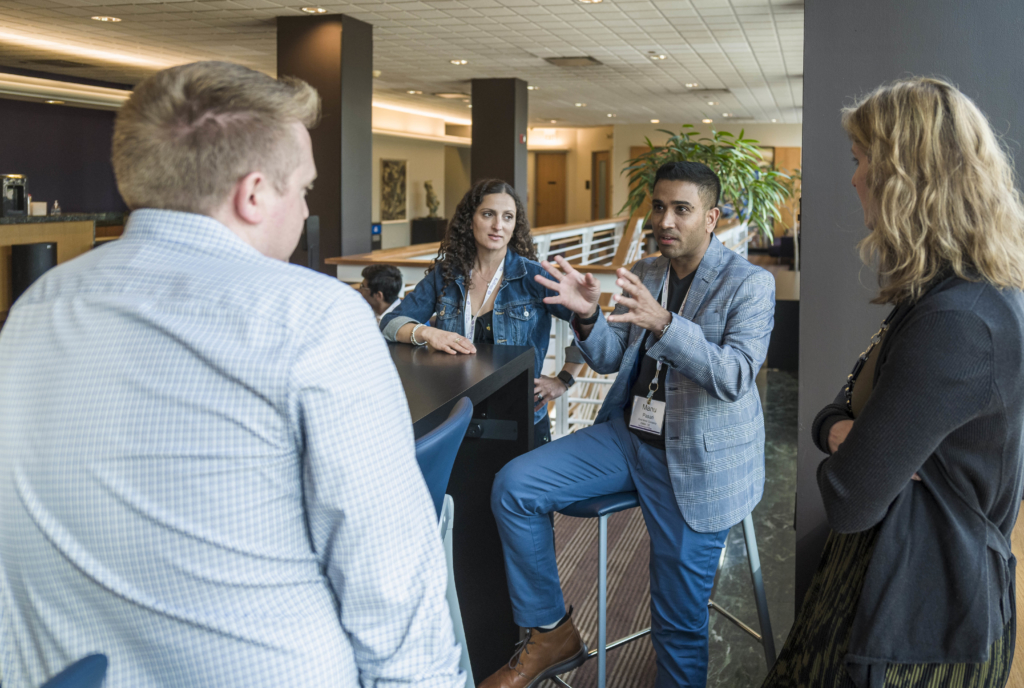
Kellogg EMBA students. Courtesy photo
You wrote your Harvard Business Review article in March 2021, about a year into the pandemic. What’s changed in exec ed since then, now that we are settling into what may be a new normal?
During the early days of the pandemic, we were completely shut down and we were forced to resort to one of two things: Either live virtual or a more blended, hybrid modality. Now we have modalities that will still be hybrid, but hybrid by choice rather than hybrid by force. As an example, I taught my MBA class last year as hybrid by force because we had capacity restrictions in the classroom. So half my class was in person, half of them were remote, but remote like a mile away.
Fast forward to now, and imagine I’m teaching an in-person MBA class:, I will still use the online modality but in a different way. What I learned was it was really interesting how I could get CEOs to come in for a five minute cameo. In one class, I actually brought in three different guest speakers for five minutes each in a live virtual program. So, I’m discussing a company, and I can say, “Wait a minute. We’ve got somebody on the line.” A CEO pops into the conversation and explains what they actually did in a case.
Do you foresee colleagues at Kellogg or at other business schools adopting some of these ideas in their exec ed programs? Are Kellogg faculty on board with this approach?
It’s a normal distribution, right? If you take a couple hundred Kellogg faculty, there are a small number who love the model and really want to embrace it. Then you have the other extreme who say they never liked this online nonsense and want to get back to their chalk and blackboard in the classroom. Most are somewhere in between.
Here’s the problem: During the pandemic, everybody had to play ball. But now that choice is back, a bunch of people are choosing to go back to the old world order. What we have to do as a leadership team is to create incentives and sticks to move people in this direction. The problem is we can’t mandate. We have to sort of coax, cajole, and employ positive shame.
It’s been a mixed bag. It’s been sort of challenging to bring along the masses within faculty. There is clearly a group of faculty who are very engaged or very innovative. Now we have 35 plus executive education courses that we offer, on and off, through this hybrid online modality. But it’s still a very small subset of the faculty.
What are some of the obstacles to adapting in-person courses to a hybrid format?

Kellogg School of Management. Courtesy photo
There are some very challenging questions that business schools will have to grapple with related to compensation and incentives. For example, let’s say that we are teaching core finance. Now we take some of that content and we make it asynchronous, and it gets rolled out repeatedly: How do I, as a professor, get paid for that? We are a T&M model (time and materials) for a certain number of contact hours.
We have to, really, create asynchronous content and get a royalty every time that content is used. We don’t have compensation mechanisms that are so forward thinking at the moment. We get paid to teach a session, and that’s not going to be good enough in the future.
Also, what are the IP (intellectual property) implications if I create content for a particular program that can be reused in another program? In fact, I wanted to use a module that one of my colleagues created for another program and I asked him for permission. He said no because he said I was going to cannibalize the audience.
So there are a lot of interesting questions to deal with. When you take content, record it, and create asynchronous content, then it becomes a product. How is that product paid for, how is it used, what’s the IP?
And what about the students? Do they want more of these innovations, or do they want to be back in the classroom?
We’ve learned a lot through the experience, and it really depends not so much on their attitude towards innovation or having options, it depends on the program they’re interested in. So our Evening and Weekend students absolutely love these ideas, because for them, they’re working, and the ability to be self paced and on demand is a phenomenal value proposition. In fact, our Evening and Weekend students rated the same course higher for the online than in-person. Now you come to the full-time MBA program, it’s a very different reaction. So we have to be very careful that in the full time MBA program, our asynchronous content has to be a complement, not a substitute, for the class instruction. .
As far as executive education is concerned, which are non-degree programs, it’s all over the place. Some people want it in person. Some people want live-virtual.
Is an omni channel model one that business schools without Kellogg’s resources could replicate? Or is it a case where they’ll be forced to in order to meet change student preferences?
Well, I’ll tell you a story to illustrate the point. In the 1920s, the gramophone was invented, and musicians singers could record their content. So what do you think happened to the average earnings of musicians?
The mean went down, the variance went up. On the average people made less money because a lot less people were willing to come in and see live concerts. But the few people who were stars made a ton of money. This is what we call superstar economics: Very few artists make a lot of money, and the rest of them kind of fade into obscurity.
The same thing will happen to business schools and, within business schools, the same thing is going to happen to faculty: A very small subset of faculty will reap disproportionate rewards because they can get royalties from asynchronous content and achieve scale.
For business schools, if Kellogg is able to expand our reach and have thousands and thousand of people take the Kellogg experience, why would a student go to a tier three business school? If those tier three business schools compete online, then our brand and our domain expertise wins. It’s actually going to, I think, create a further sort of chasm between the haves and the have nots.
Is there a breaking point to this model then? Is there a point where it is actually hurting more than it is hurting?
Hurting who, right? I think it’s helping customers. I mean, I have to say that the price of our Executive MBA Program is a disgrace: $200,000, I mean we’re pricing ourselves out of the market.
Let me tell you a provocative thought: I believe that the executive MBA program in future should be $500,000, not $200,000, but then we will create a $25,000 version for the masses. In between, you are neither providing that really rich in-person experience for the people who want that and can afford that. Nor are you providing the reach and scale and the democratization of executive education for the people who want a credential, people who want that learning, but don’t have the means or are financially or logistically constrained to be able to come in person. If you fall in the middle, where you’re neither here nor there, you’re dead.
What are the big takeaways, in your opinion, for EMBA and executive education after two to three years of the pandemic?
I think one takeaway is it’s not about online or in person. That’s a false dichotomy. It’s really thinking about the combination of modalities that creates the best experience for that particular audience. So omni channel.
The second big takeaway is that for executive education, once you start to scale the reach to get into the marketplace, there’s a flight from quality. Whether it’s a school that doesn’t have the brand name or, honestly, faculty who’ve been teaching old stuff. Like Warren Buffett said, “Now the tide has gone out, you can figure out who’s been swimming naked.” Because in the market, honestly, people are not going to come and learn Finance 101 executive education online, they’re going to come for digital marketing. They’re going to come for mergers and acquisition. They’re going to come for the latest sustainability, Crypto, and AI. So as faculty, we have to really reinvent ourselves to be cutting edge. The market will speak. You can’t just hide behind your brand and keep doing simple stuff.
And then I think the other part here is that we really have to think very carefully about incentives, compensation and how we work through IP issues and so on.
Lastly, I will say that in terms of superstar economics, it takes a different kind of talent to be a star online. Not everybody who’s really good in the classroom is really good at creating these blended programs. We are not only teachers now, we also have to become performers. At business schools, you will need to figure out where are your instructional designers? Where are your studios? Where are all of the post production capability in the content management system?
We are becoming technology companies now, we have to do product development. I think we haven’t wrapped our heads around the capability that we’ll have to build from a digital infrastructure standpoint, from a talent standpoint, from a support standpoint, from a marketing standpoint. It’s a different business we are headed towards and we have to scale up for that.
Anything else you’d like to add?
I think that in conclusion, the only thing I’d say is that I doubt that faculty, executive education administration, and the deans at business schools understand the scope, the scale, and the speed of disruption that is coming to executive education. I think that while the pandemic kind of accelerated innovation, the danger now is we are lapsing back into our old bad habits. When you read what’s on your rear view mirror, what does it say? It says, “Objects in this mirror are closer than they appear.” This disruption is coming to a business school near you.
It’s not Wharton that’s gonna disrupt Kellogg. Honestly, we’re all kind of resting on our laurels. And, we’re doing good things, don’t get me wrong. But, invasion comes from below. It comes from the Section 4s, it comes from the Heart Business Schools, it comes from the University of Wisconsins doing really creative partnerships.
DON’T MISS WHARTON GOES ONLINE, LAUNCHING A GLOBAL EXECUTIVE MBA and 7 BIGGEST REGRETS FROM THE CLASS OF 2022 BEST & BRIGHTEST





Questions about this article? Email us or leave a comment below.